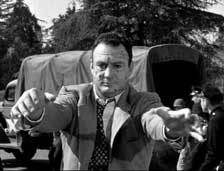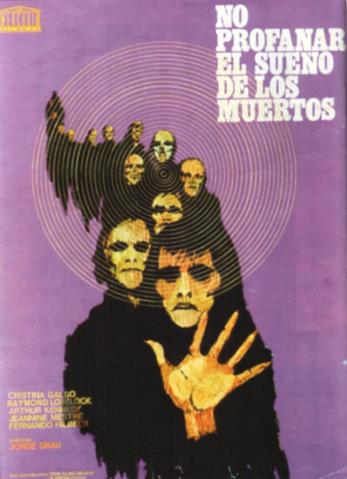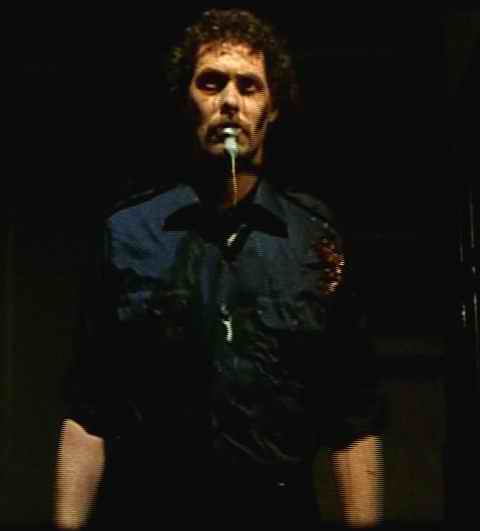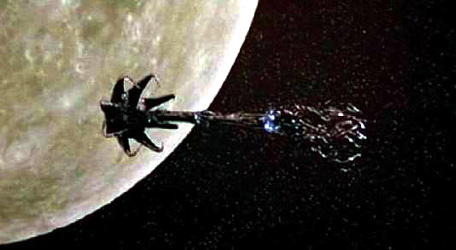Mansion Of The Living Dead
by Jesús Franco

If he were at all interested in telling the truth or (or making good movies) he would have called this Abandoned Hotel of the Skull-Faced Rapists; now that's a title I can feel good about! Four women with atrocious eighties hair and clothing pull into a deserted island hotel and make some truly irreverent small talk. At least it's actually in Spanish and doesn't appear to have been dubbed. One of them has a shiny silver bowl cut and...hey, isn't that Lina Romay? She's gained some weight since Female Vampire, convinced Franco she deserved a speaking role, and she looks she was just fired from the B-52s. They go into the lobby and the whole place is devoid of other guests or wait staff. Just when they plan to leave the creepy blonde hotel manager pops up and gives them two rooms, claiming the others are all booked. There is a weird bit of tension as the four women decide who they'll room with. This is because they have all been keeping their affairs secret from one another in the mistaken belief that the girls they are not sleeping with are nun-style prudes. The second they get into their rooms, each pair has essentially the same conversation about being worried they would end up sharing the rooms with those prudes. Now that they're alone, relieved, they all take their clothes off and start making out. Well, it's been 10 minutes and Franco already has four unattractive women licking each other. I'm not 100% on this, but I'm nearly positive that Franco was the guy who invented this style of filmmaking where female characters spend three quarters of the film naked. They do ordinary things, have conversations, eat, talk on the telephone, walk around, but their breasts are fully exposed. Guess you can't fault a guy for making a film he wants to watch. I just wish he had never released them, cause he's been encouraging a lot of assholes to do the same thing.
 Well it seems the girl's have all forgotten their swimming suits and go out to the empty beach in varying states of nudity. That's when someone drops a clever from a balcony that lands between two of them and the creepy janitor shows up. He serves no purpose, I assure you. Well, aside from the mounting weirdness and paucity of other people, flying knives, a peeping tom custodian, and apparently no food or drink to be had, nothing's too out of place and so they settle in for the night and the women start screwing again (well, sort of...i'll come back to that). The next morning one of the girls goes out for a stroll and finds her way into an old monastery nearby. She finds something terrible, screams and disappears from the plot. They never mention her again, except in the context of her girlfriend being mysteriously horny all of the sudden. The other girls go looking for food and the janitor gives them the "I'm lazy and women belong in the kitchen" routine. One of the girls, I can't tell them apart so I'll just call her the brunette, fed up with this goes for a walk and finds the hotel manager. They waste no time in having sex, but he stops when he hears the chiming of a clock. He leaves with her an excuse about having to feed a sick woman and that he'll meet her tomorrow in his car. This is just about the time we meet the woman on the dog collar. The hotel manager brings a tray of food to a naked woman chained up in one of the rooms. She wants to eat and he finds that disgusting, for some reason. He complains of how much like an animal she's becoming "You just eat and shit". He then starts having sex with her but stops so that she'll want more. Jesús Franco: feminist first, filmmaker second.
Well it seems the girl's have all forgotten their swimming suits and go out to the empty beach in varying states of nudity. That's when someone drops a clever from a balcony that lands between two of them and the creepy janitor shows up. He serves no purpose, I assure you. Well, aside from the mounting weirdness and paucity of other people, flying knives, a peeping tom custodian, and apparently no food or drink to be had, nothing's too out of place and so they settle in for the night and the women start screwing again (well, sort of...i'll come back to that). The next morning one of the girls goes out for a stroll and finds her way into an old monastery nearby. She finds something terrible, screams and disappears from the plot. They never mention her again, except in the context of her girlfriend being mysteriously horny all of the sudden. The other girls go looking for food and the janitor gives them the "I'm lazy and women belong in the kitchen" routine. One of the girls, I can't tell them apart so I'll just call her the brunette, fed up with this goes for a walk and finds the hotel manager. They waste no time in having sex, but he stops when he hears the chiming of a clock. He leaves with her an excuse about having to feed a sick woman and that he'll meet her tomorrow in his car. This is just about the time we meet the woman on the dog collar. The hotel manager brings a tray of food to a naked woman chained up in one of the rooms. She wants to eat and he finds that disgusting, for some reason. He complains of how much like an animal she's becoming "You just eat and shit". He then starts having sex with her but stops so that she'll want more. Jesús Franco: feminist first, filmmaker second.The hotel manager takes the brunette to the monastery in his car and then leaves her there, telling her not to go anywhere. She gets out seconds later, wanders into the monastery, and meets a group of men in white hoods with plastic skull masks. The only exception is the head priest who looks like some large animal spit on his face and he never wiped it off. The men seize her, declare her a sinner and strip her clothes off. Spit-face reads a perverted scripture (dedicated to satan instead of god, some real excellent writing) while the guys in skull masks take turns raping her and then they stab her in her vagina. We will never learn why.
The remaining two girls decide to shack up together now that their partners have both gone missing and it takes them about a minute and 30 seconds before they get down to having sex. They find the body of one of the girls lying naked in the pool, dead. They go to report it to the hotel manager, but he hilariously tells them that's an issue for the help desk, which is clearly fucking empty. Lina Romay and the hotel manager meet in the hallway, just like the other girl did, and he promises to get her out. He leaves her and then she takes to wandering (can't say I blame her, as I was tempted to do the same thing during this film). She meets dog collar girl, who explains that yes, she hates the hotel manager for locking her up, but no she doesn't want to leave. She explains while eating a sickening amount of food with her hands that she has become enthrall to him and likes being starved, chained, and taken out to piss on a dog collar. Then, out of nowhere, she gets jealous and insists that Lina take her silver wig and beat it before her man comes back. She wisely backs out of the room and then unwisely heads over to the monastery. There they do the handing down of the verdict (guilty!) and then start raping her. She then discovers the true identity of spit-face, which while being the only logical explanation, doesn't really make any sense.
Let's go over the things that are never explained in this movie: Why the girls have kept their affairs secret; why the hotel is abandoned; Who the dog-collar girl is; Why the white-sheet boys are doing what they're doing; who they are; why they worship satan; why they let Lina Romay live but not her friends; why peeling off their face make-up kills them; which girl is found in the pool; who the janitor is; why some of the cult members have plastic skull masks; what the hell Jesús Franco was thinking. I've heard rumours that this was supposed to be a remake of Tombs of the Blind Dead, which I guess makes sense elementally, but, wow. Who knew something could ever make Tombs of the Blind Dead look superior to another film (by leaps and bounds no less). Of course, if this was intended as a remake, Franco never told anyone until it was done. There is no talk of Knights Templar so I assume that business was just a little too complicated for him to understand. "Skeletons in hoods killing ugly women? I can do that!" It only took me one other movie in his canon to find something worse than Female Vampire, so imagine how much better Tombs of the Blind Dead looks next to this.
 The only thing more off-putting than watching the men in white forcing themselves on the four women is watching the women give themselves to one another. Lina Romay, Eva León, Mabel Escaño, and Mari Carmen Nieto were no strangers to pornography at the time so it's more than strange that they apparently had no idea how to convincingly fake having sex with each other. Now, I don't mean to say that I think this is ever called for in a movie, or that had they done a good job it would have saved the movie, but there's something profoundly silly about watching four grown women pretending to like having sex with each other. When Lina and her girlfriend start kissing it looks like they both can't stand each other and they both wince visibly. I guess you can only be forced to act like a lesbian for so many years before a naked girl can just make you mad. It's like watching two awkward teenagers forced to do it in a game of spin the bottle. They don't really like each other and were hoping they would land on the quarterback. And then there's their acting outside the bedroom. And I'm not sure what Lina Romay did to convince Jesús that she deserved a speaking role, but it wasn't worth it. She and the other girls talking drags this movie out much more than it can withstand. In fact, seeing as there isn't anything remotely frightening or relevant in the movie, everything makes it drag. This movie in general is a drag. Franco does everything in his power to make the sex as ugly and uncomfortable as possible; like when Lina Romay sits down on the toilet (with the intention of urinating if I'm not mistaken), and her girlfriend sits down opposite her and they start stripping and making out. She's on the fucking toilet, Jesús! Have some dignity. It's no wonder everyone was so turned off.
The only thing more off-putting than watching the men in white forcing themselves on the four women is watching the women give themselves to one another. Lina Romay, Eva León, Mabel Escaño, and Mari Carmen Nieto were no strangers to pornography at the time so it's more than strange that they apparently had no idea how to convincingly fake having sex with each other. Now, I don't mean to say that I think this is ever called for in a movie, or that had they done a good job it would have saved the movie, but there's something profoundly silly about watching four grown women pretending to like having sex with each other. When Lina and her girlfriend start kissing it looks like they both can't stand each other and they both wince visibly. I guess you can only be forced to act like a lesbian for so many years before a naked girl can just make you mad. It's like watching two awkward teenagers forced to do it in a game of spin the bottle. They don't really like each other and were hoping they would land on the quarterback. And then there's their acting outside the bedroom. And I'm not sure what Lina Romay did to convince Jesús that she deserved a speaking role, but it wasn't worth it. She and the other girls talking drags this movie out much more than it can withstand. In fact, seeing as there isn't anything remotely frightening or relevant in the movie, everything makes it drag. This movie in general is a drag. Franco does everything in his power to make the sex as ugly and uncomfortable as possible; like when Lina Romay sits down on the toilet (with the intention of urinating if I'm not mistaken), and her girlfriend sits down opposite her and they start stripping and making out. She's on the fucking toilet, Jesús! Have some dignity. It's no wonder everyone was so turned off.The Creature With The Atom Brain
by Ed Cahn
 Finally, a schlock man I can tolerate. If you couldn't tell from it's title this film is a solid piece of red scare tripe. We see a man break into a gambler named Hennessy's house (through the steel barred windows) and murder someone as he's counting his money and putting it in his safe. His death throws are recorded in the man's personal recorder as he's commenting on his takings for the day. The police are as baffled by the assailant's super-human strength as they are by the words the man says before killing his target. "This is Frank Buchanan...I told you I'd see you die!" The last thing Hennessy says is that the man doesn't look a thing like Buchanan. That could be because Buchanan is controlling the man with the help of a mad scientist called Steigg. The police find no trace of the hitman, but the next day when a DA turns up dead in his garage under similar circumstances, they suspect a connection. Both men were involved in the arrest of notorious gangster Frank Buchanan. They check into it; he's supposed to have been in a Roman prison after having been exiled from the states following his jail-time. Well, as the audience has no doubt figured out, he's gotten out and teamed up with Steigg. Why has the German doctor agreed to murdering people? Well he was once a Nazi scientist who has since fallen out of society's good graces and was forced into a basement laboratory when Buchanan found him. Obviously Nazi beggars can't be choosers, so in exchange for funding and a detour in revenge city, the two began their work.
Finally, a schlock man I can tolerate. If you couldn't tell from it's title this film is a solid piece of red scare tripe. We see a man break into a gambler named Hennessy's house (through the steel barred windows) and murder someone as he's counting his money and putting it in his safe. His death throws are recorded in the man's personal recorder as he's commenting on his takings for the day. The police are as baffled by the assailant's super-human strength as they are by the words the man says before killing his target. "This is Frank Buchanan...I told you I'd see you die!" The last thing Hennessy says is that the man doesn't look a thing like Buchanan. That could be because Buchanan is controlling the man with the help of a mad scientist called Steigg. The police find no trace of the hitman, but the next day when a DA turns up dead in his garage under similar circumstances, they suspect a connection. Both men were involved in the arrest of notorious gangster Frank Buchanan. They check into it; he's supposed to have been in a Roman prison after having been exiled from the states following his jail-time. Well, as the audience has no doubt figured out, he's gotten out and teamed up with Steigg. Why has the German doctor agreed to murdering people? Well he was once a Nazi scientist who has since fallen out of society's good graces and was forced into a basement laboratory when Buchanan found him. Obviously Nazi beggars can't be choosers, so in exchange for funding and a detour in revenge city, the two began their work.One side-effect of their volatile experimenting is that the radiation they've been using to control people has started to rub off in the crime scenes (the first real clue!). Equally disconcerting is that the fingerprints left behind belong to a man who, not a week earlier had succumb to tuberculosis. Now this doesn't make a lick of sense until the police read about the robbery of eight corpses from the city morgue. Chet Walker (They call him Dr. and he's in the employ of the police, so I take it that he's some kind of proto-forensics man), and his boss Captain Harris get the aid of the military in setting up radiation-detecting equipment to scour the city. In the meantime, they've hired police escorts to guard the other men who sold Buchanan up the river all those years ago. The police don't expect him to use a zombie-uniform cop to show up to relieve the guard at assistant DA Franchot's house (chalk another one up for Buchanan and the Nazi). So as Buchanan's hit list gets smaller, the police get closer to finding the madman. This worries Buchanan and so he starts to expand his remote control murders to the police investigating. He turns captain Harris into a zombie and sends him to Dr. Walker's house with the intent of menacing his wife and daughter. All they can manage to make him do is break his daughter's doll into a dozen pieces and then leave. The police stop the zombie cop when he crashes his car, scrambling the signals from Buchanan and Steigg. Now all he wants to do is find Buchanan and kill him. The police and the military follow him back to Buchanan's place, but he's not interested in going quietly. He sends the reanimated corpses out to face them on his front lawn while Walker tries to overpower Buchanan and stop the zombie attack.
Cahn knew how to make a solid zombie picture, if nothing else. He was making every kind of reanimated corpse film there was to make in those pre-Romero days. The composition, acting, and action scenes are all respectfully done and all the scenes with zombie attacks are handled really well. The first attack where we see the zombie breaking Hennessy like a fourth-of-july popper is pretty effective. As is the final confrontation between the well-dressed undead and the military men. Cahn knew the cinematic appeal of watching men in suits fighting in large groups better than any other American director. Of course, the film is helped by the script by Curt Siodmak, writer of I Walked With A Zombie, The Wolf Man, The Beast With Five Fingers, and Earth Vs. The Flying Saucers, one of a handful of german émigrés who made American movies better in the 40s and 50s. This movie's script takes it's cues from two different movies. Obvious are the connections between this and another commie-horror movie; Howard Hawks' The Thing From Another World. However, despite the thematic similarities, the movie that Creature owes the greatest debt to is Fritz Lang's The Big Heat. We have someone working with the police tirelessly, distracted from his family. We have a gangster who can't be touched (though for reasons of anonymity rather than status), killing people and eventually attempting to harm our heroes family (a wife and daughter in both cases). We have our hero and villain duking it out at the latter's lavish pad. We have crooks turning straight and then being killed. Both films were made in part by left-wing German noir-men, and both are fairly routine, very solid examples of their genres. Even the actress who plays Walker's daughter, Linda Bennett, plays Glenn Ford's daughter in The Big Heat, doing exactly the same role. The framing story of the police vs. gangsters is basically identical. Creature strives towards being family friendly and so shies away from the outright viscousness of Lang's film, because producer Sam Arkoff was much more interested in appealing to wider audiences than Fritz Lang (his best known film is about a child murderer for god's sakes). In losing the motivated lighting and murky character-lines of its precursor, director Ed Cahn had a less interesting plot-arc to work with, but he was free to bring in his visual trademarks: pandemonium-via-stock footage, large groups of men marching together, old fashioned fisticuffs between two square-jaws. There's that sense of global annihilation Cahn repeatedly strove for, even if the problem couldn't be more localized. Cahn's films have conviction that many 50s sci-fi films lack; he's not afraid to end a film in broad daylight, or to make the villain look like a human being. His romances are always tastefully done, instead of put upon like SO many films of the period; with guys like Arkoff screaming at you for a romantic ending, it must have been a challenge to be so reasonable about it, but he's rarely disappointed in this regard. Here our hero is already married and clearly cares about his family, but understands that in cases that involve radioactive zombies, he's got to see the big picture, and his smugness even serves to add some conviction when he explains to his daughter that Harris won't be coming by their house anymore. Considering Arkoff's other films it could have been much worse. In fact I used Arkoff's other work to back me up here. Sam put his money into a lot of films, but Cahn's never looked as pitiful as the directors of say The Giant Claw, Earth Vs. The Spider or The Amazing Colossal Man and its sequel. I say bravo.

El Santo at 1000 Misspent Hours & Counting has commented how much Ted V. Mikels stole from Creature With The Atom Brain for his Astro Zombies, which makes this film one rung midway up a very interesting ladder (Lang, Hawks, Cahn, Mikels? Just imagine where it ends). While he comments on all the plot similarities (and there are many), he might also be interested to know that the name of the Assistant DA in Creature is also the name of John Carradine's hideous lab assistant in Astro Zombies. Now that's generally something people do when they're nodding at their heroes (Final Destination, Slither, Night of the Creeps), but Creature was only 10 years old when Mikels made his movie; still it's tough to imagine someone being so completely oblivious to copyright laws that he would go so far as to outright steal the names of characters. But this is 60s horror we're talking about, so no plot (on or off screen) is too wildly unfounded.
































